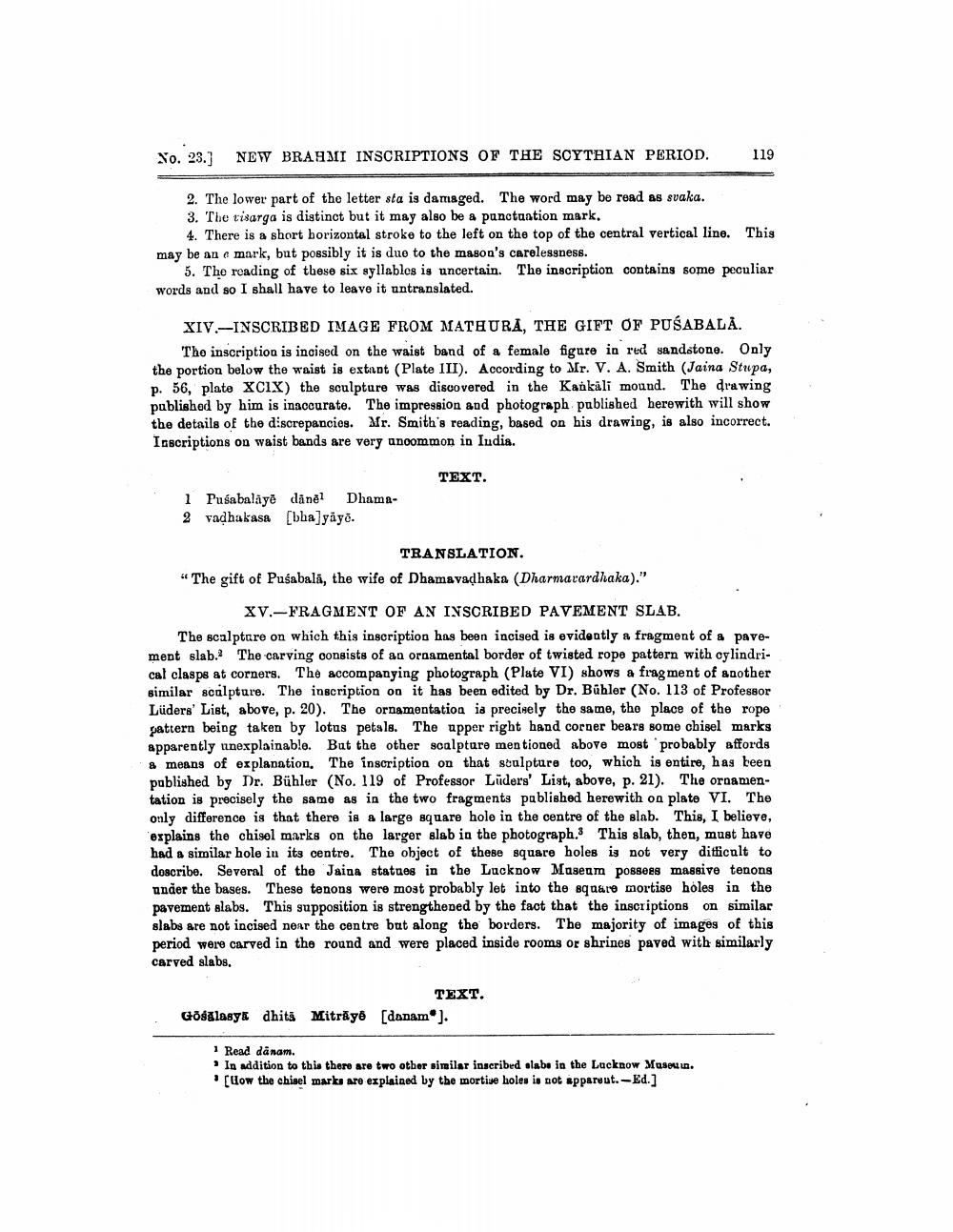________________
Xo. 23.) NEW BRASMI INSCRIPTIONS OF THE SCYTHIAN PERIOD.
119
2. The lower part of the letter sta is damaged. The word may be read as svaka. 3. The tisarga is distinct but it may also be a punctuation mark.
4. There is a short horizontal stroke to the left on the top of the central vertical line. This may be an e mark, but possibly it is due to the mason's carelessness.
5. The reading of these six syllables is uncertain. The inscription contains some peculiar words and so I shall have to leave it untranslated.
XIV.-INSCRIBED IMAGE FROM MATHURA, THE GIFT OF PUSABALĀ.
The inscription is incised on the waist band of a female figure in red sandstone. Only the portion below the waist is extant (Plate III). According to Mr. V. A. Smith (Jaina Stupa, p. 56, plate XCIX) the sculpture was discovered in the Kankäli mound. The drawing published by him is inaccurate. The impression and photograph published herewith will show the details of the discrepancies. Mr. Smith's reading, based on his drawing, is also incorrect. Inscriptions on waist bands are very unoommon in India.
TEXT.
1 Pusabalayé daněl Dhama2 radhakasa [bha)yayo.
TRANSLATION. "The gift of Puśabala, the wife of Dhamavadhaka (Dharmavardhaka)."
XV.-FRAGMENT OF AN INSCRIBED PAVEMENT SLAB. The scalptare on which this inscription has been incised is evidently a fragment of a pavement slab. The carving consists of an ornamental border of twisted rope pattern with cylindrical clasps at corners. The accompanying photograph (Plate VI) shows a fragment of another similar scnlpture. The inscription on it has been edited by Dr. Bühler (No. 113 of Professor Lüders' List, above, p. 20). The ornamentation is precisely the same, the place of the rope pattern being taken by lotus petals. The upper right hand corner bears some chisel marks apparently unexplainable. But the other scalpture mentioned above most probably affords & means of explanation. The inscription on that sculpture too, which is entire, has been published by Dr. Bühler (No. 119 of Professor Lüders' List, above, p. 21). The ornamentation is precisely the same as in the two fragments pablished herewith on plate VI. The only difference is that there is a large square hole in the centre of the slab. This, I believe, explains the chisel marks on the larger slab in the photograph. This slab, then, must have had a similar hole in its centre. The object of these square holes is not very difficult to describe. Several of the Jaina statues in the Lucknow Maseam possees massive tenons under the bases. These tenons were most probably let into the equa10 mortise holes in the pavement slabs. This supposition is strengthened by the fact that the inscriptions on similar slabs are not incised near the centre but along the borders. The majority of images of this period were carved in the round and were placed inside rooms or shrines paved with similarly carved slabs.
TEXT. dhita Mitrāyo [danam®].
Gošalasy
Read danam. In addition to this there are two other similar inscribed slabe in the Lucknow Museu in. (low the chisel marks are explained by the mortise holes is not apparuut. -Ed.]




